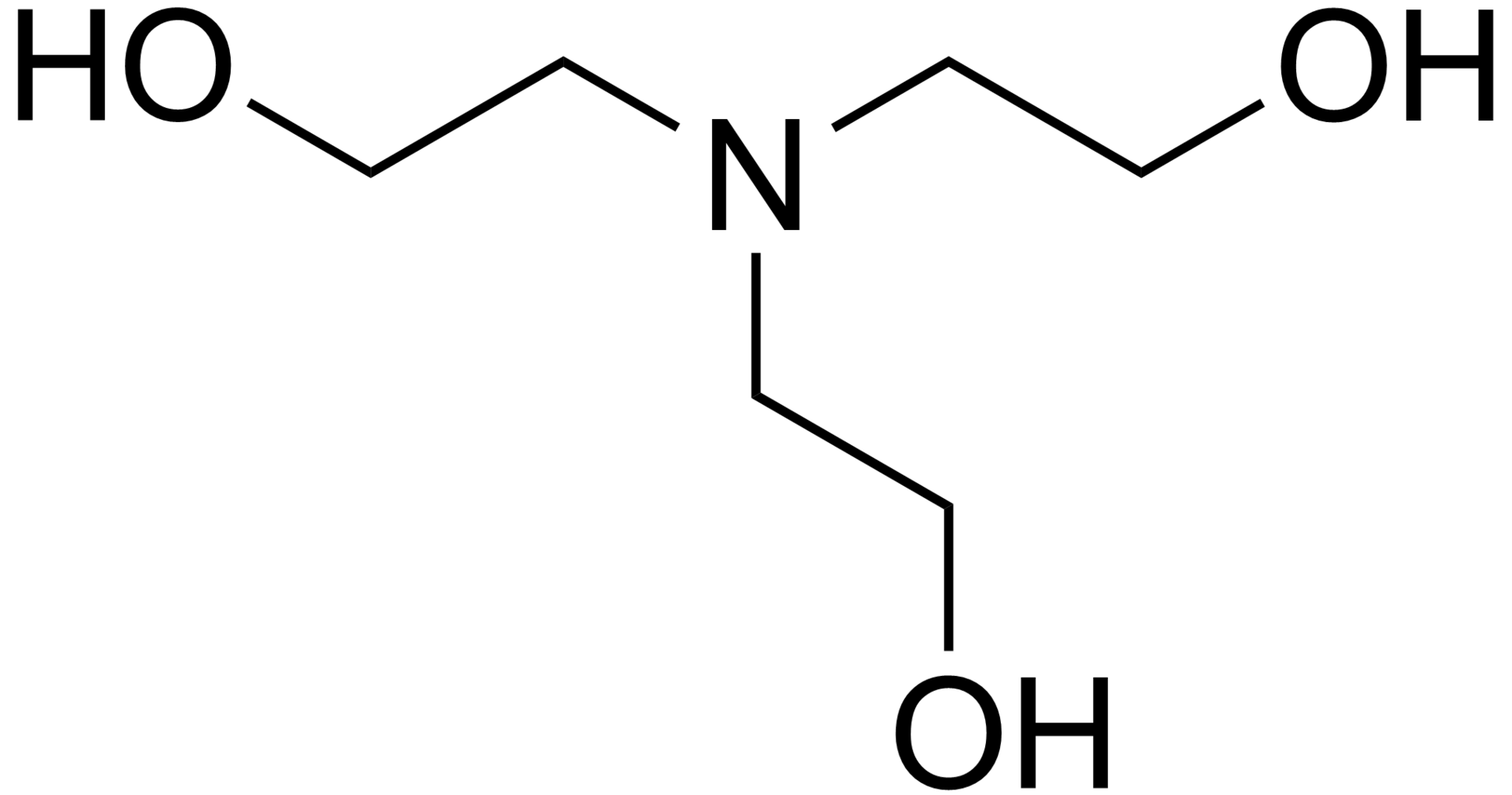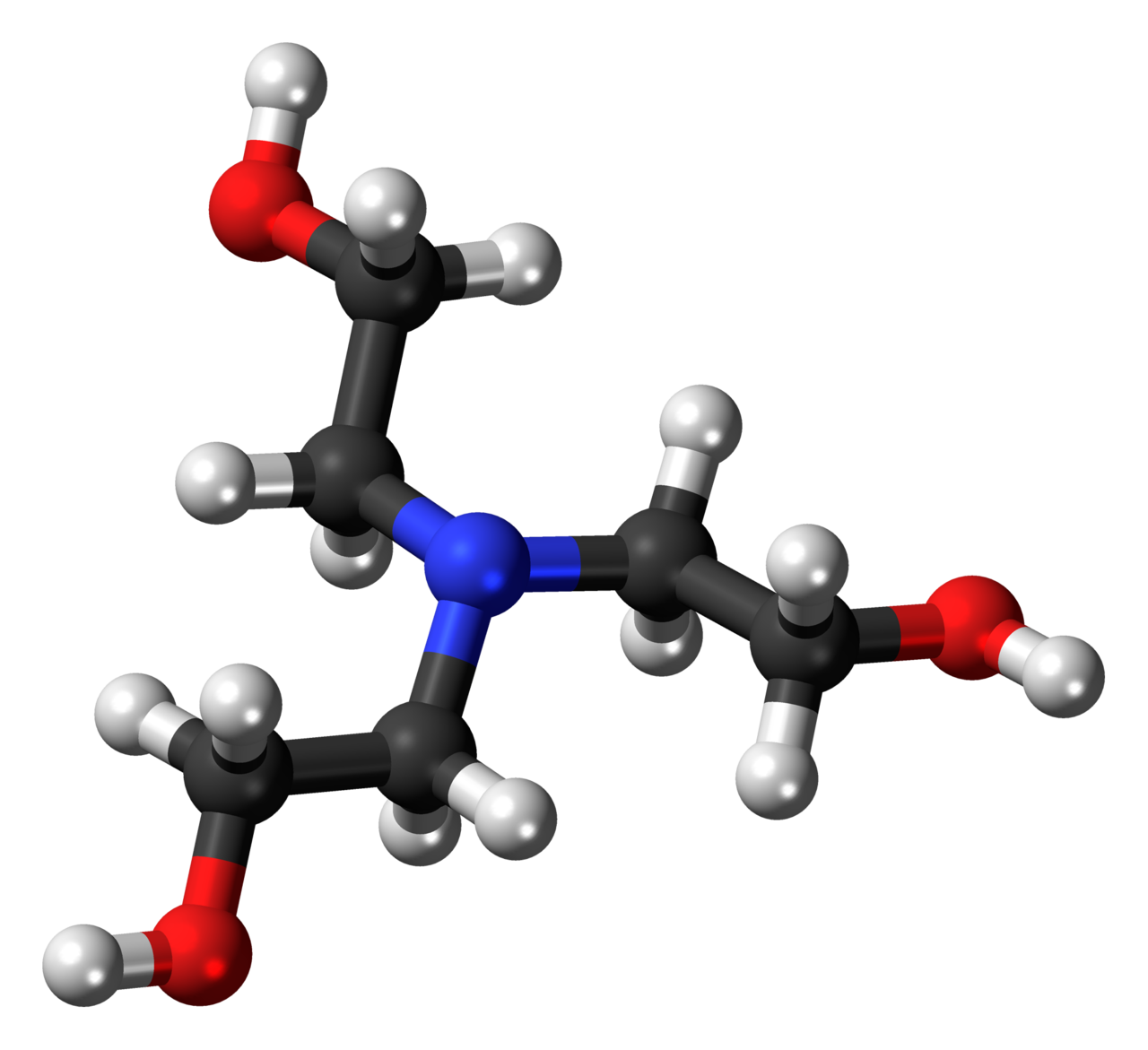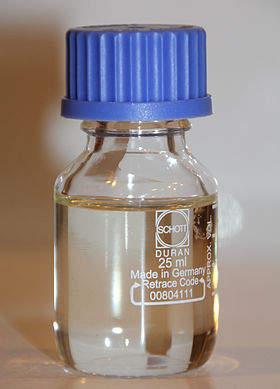Triethanolamine: Difference between revisions
No edit summary |
m (Protected "Triethanolamine": Bot: Protecting all pages from category Drug ([Edit=Allow only administrators] (indefinite) [Move=Allow only administrators] (indefinite))) |
||
| (One intermediate revision by one other user not shown) | |||
| Line 4: | Line 4: | ||
| ImageFile = Triethanolamine.png | | ImageFile = Triethanolamine.png | ||
| ImageFile_Ref = {{chemboximage|correct|??}} | | ImageFile_Ref = {{chemboximage|correct|??}} | ||
| ImageSize = | | ImageSize = 180px | ||
| ImageAlt = Skeletal formula of triethanolamine | | ImageAlt = Skeletal formula of triethanolamine | ||
| ImageFile1 = Triethanolamine_3D_ball.png | | ImageFile1 = Triethanolamine_3D_ball.png | ||
| ImageSize1 = | | ImageSize1 = 160px | ||
| IMageAlt1 = Ball-and-stick model of the triethanolamine molecule | | IMageAlt1 = Ball-and-stick model of the triethanolamine molecule | ||
| ImageFile2 = 280px-Sample_of_Triethanolamine.jpg | | ImageFile2 = 280px-Sample_of_Triethanolamine.jpg | ||
| ImageSize2 = | | ImageSize2 = 140px | ||
| ImageName2 = Liquid form | | ImageName2 = Liquid form | ||
| ImageAlt2 = Colorless liquid in a stoppered glass bottle | | ImageAlt2 = Colorless liquid in a stoppered glass bottle | ||
Latest revision as of 17:20, 20 August 2015

| |

| |

| |
| Names | |
|---|---|
| IUPAC name
Tris(2-hydroxyethyl)amine
| |
Other names
| |
| Identifiers | |
3D model (JSmol)
|
|
| ChEBI | |
| ChEMBL | |
| ChemSpider | |
| ECHA InfoCard | Lua error in Module:Wikidata at line 879: attempt to index field 'wikibase' (a nil value). Lua error in Module:Wikidata at line 879: attempt to index field 'wikibase' (a nil value). |
| KEGG | |
| MeSH | Biafine |
PubChem CID
|
|
| UNII | |
| |
| |
| Properties | |
| C6H15NO3 | |
| Molar mass | 149.19 g·mol−1 |
| Hazards | |
| Related compounds | |
Except where otherwise noted, data are given for materials in their standard state (at 25 °C [77 °F], 100 kPa). | |
| Infobox references | |
|
WikiDoc Resources for Triethanolamine |
|
Articles |
|---|
|
Most recent articles on Triethanolamine Most cited articles on Triethanolamine |
|
Media |
|
Powerpoint slides on Triethanolamine |
|
Evidence Based Medicine |
|
Clinical Trials |
|
Ongoing Trials on Triethanolamine at Clinical Trials.gov Trial results on Triethanolamine Clinical Trials on Triethanolamine at Google
|
|
Guidelines / Policies / Govt |
|
US National Guidelines Clearinghouse on Triethanolamine NICE Guidance on Triethanolamine
|
|
Books |
|
News |
|
Commentary |
|
Definitions |
|
Patient Resources / Community |
|
Patient resources on Triethanolamine Discussion groups on Triethanolamine Patient Handouts on Triethanolamine Directions to Hospitals Treating Triethanolamine Risk calculators and risk factors for Triethanolamine
|
|
Healthcare Provider Resources |
|
Causes & Risk Factors for Triethanolamine |
|
Continuing Medical Education (CME) |
|
International |
|
|
|
Business |
|
Experimental / Informatics |
Editor-In-Chief: C. Michael Gibson, M.S., M.D. [1]
Overview
Triethanolamine, often abbreviated as TEA, is a viscous organic compound that is both a tertiary amine and a triol. A triol is a molecule with three alcohol groups. Triethanolamine is a strong base.[2] Triethanolamine can also be abbreviated as TEOA, which can help to distinguish it from triethylamine. Approximately 150000 metric tons were produced in 1999.[3] It is a colourless compound although samples may appear yellow because of impurities.
Applications
Triethanolamine is used primarily as an emulsifier and surfactant. It is a common ingredient in formulations used for both industrial and consumer products. The triethanolamine neutralizes fatty acids, adjusts and buffers the pH, and solubilises oils and other ingredients that are not completely soluble in water. Some common products in which triethanolamine is found are liquid laundry detergents, dishwashing liquids, general cleaners, hand cleaners, polishes, metalworking fluids, paints, shaving cream and printing inks.[4]
Cosmetics and medicine
Various ear diseases and infections are treated with eardrops containing triethanolamine polypeptide oleate-condensate, such as Cerumenex in the United States. In pharmaceutics, triethanolamine is the active ingredient of some ear drops used to treat impacted earwax. It also serves as a pH balancer in many different cosmetic products - ranging from cleansing creams and milks, skin lotions, eye gels, moisturizers, shampoos, shaving foams etc. TEA is a fairly strong base: a 1% solution has a pH of approximately 10, whereas the pH of skin is below pH 7, more or less 5.5-6.0. Cleansing milk/cream emulsions based on TEA are particularly good at removing makeup.
Safety and regulation
Allergic reactions
A 1996 study found that triethanolamine (TEA) occasionally causes contact allergy.[5] A 2001 study found TEA in a sunscreen caused an allergic contact dermatitis.[6] A 2007 study found TEA in ear drops caused a contact allergy.[7] Systemic and respiratory tract (RT) toxicity was analyzed for 28 days in a nose specific inhalation 2008 study in Wistar rats; TEA seems to be less potent in regard to systemic toxicity and RT irritancy than diethanolamine (DEA). Exposure to TEA resulted in focal inflammation, starting in single male animals from 20 mg/m3 concentrations.[8]
A 2009 study stated patch test reactions reveal a slight irritant potential instead of a true allergic response in several cases and also indicated the risk of skin sensitization to TEA seems to be very low.[9]
Tumors
Reports indicated that TEA causes an increased incidence of tumor growth in the liver in female B6C3F1 mice, but not in male mice or in Fischer 344 rats.[10] A 2004 study concluded "TEA may cause liver tumors in mice via a choline-depletion mode of action and that this effect is likely caused by the inhibition of choline uptake by cells."[10]
Environmental toxicity
A 2009 study found that TEA has potential acute, sub-chronic and chronic toxicity properties in respect to aquatic species.[11]
Regulation
TEA is listed under Schedule 3, part B of the Chemical Weapons Convention as it can be used in the manufacture of nitrogen mustards.
References
- ↑ Simond, M. R. (2012). Journal of Solution Chemistry. 41: 130. doi:10.1007/s10953-011-9790-3. Missing or empty
|title=(help) - ↑ O'Neil, MJ. The Merck Index - An Encyclopedia of Chemicals, Drugs, and Biologicals (13th Edition ed.). Whitehouse Station, NJ: Merck and Co., Inc. p. 1722. Check date values in:
|accessdate=(help);|access-date=requires|url=(help) - ↑ Matthias Frauenkron, Johann-Peter Melder, Günther Ruider, Roland Rossbacher, Hartmut Höke "Ethanolamines and Propanolamines" in Ullmann's Encyclopedia of Industrial Chemistry, 2002 Wiley-VCH, Weinheim doi:10.1002/14356007.a10_001
- ↑ Ashford’s Dictionary of Industrial Chemicals, third edition, 2011, page 9252
- ↑ Hamilton TK, Zug KA (1996). "Triethanolamine allergy inadvertently discovered from a fluorescent marking pen". Am J Contact Dermat. 7 (3): 164–5. doi:10.1016/S1046-199X(96)90006-8. PMID 8957332.
- ↑ Chu CY, Sun CC (2001). "Allergic contact dermatitis from triethanolamine in a sunscreen". Contact Dermatitis. 44 (1): 41–2. doi:10.1034/j.1600-0536.2001.440107-8.x. PMID 11156016.
- ↑ Schmutz JL, Barbaud A, Tréchot P (2007). "[Contact allergy to triethanolamine in ear drops and shampoo]". Ann Dermatol Venereol. 134 (1): 105. PMID 17384563.
- ↑ Gamer AO, Rossbacher R, Kaufmann W, van Ravenzwaay B (2008). "The inhalation toxicity of di- and triethanolamine upon repeated exposure". Food Chem Toxicol. 46 (6): 2173–83. doi:10.1016/j.fct.2008.02.020. PMID 18420328.
- ↑ Lessmann H, Uter W, Schnuch A, Geier J (2009). "Skin sensitizing properties of the ethanolamines mono-, di-, and triethanolamine. Data analysis of a multicentre surveillance network (IVDK*) and review of the literature". Contact Dermatitis. 60 (5): 243–55. doi:10.1111/j.1600-0536.2009.01506.x. PMID 19397616.
- ↑ 10.0 10.1 Stott WT, Radtke BJ, Linscombe VA, Mar MH, Zeisel SH (2004). "Evaluation of the potential of triethanolamine to alter hepatic choline levels in female B6C3F1 mice". Toxicol Sci. 79 (2): 242–7. doi:10.1093/toxsci/kfh115. PMC 1592523. PMID 15056812.
- ↑ Libralato G, Volpi Ghirardini A, Avezzù F (2009). "Seawater ecotoxicity of monoethanolamine, diethanolamine and triethanolamine". J Hazard Mater. 176 (1–3): 535–9. doi:10.1016/j.jhazmat.2009.11.062. PMID 20022426.
See also
- Pages with script errors
- Pages with citations lacking titles
- CS1 errors: dates
- Pages using citations with accessdate and no URL
- CS1 maint: Extra text
- CS1 maint: Multiple names: authors list
- Articles without InChI source
- Chemical articles with unknown parameter in Chembox
- ECHA InfoCard ID from Wikidata
- Chembox having DSD data
- Chembox having GHS data
- Articles containing unverified chemical infoboxes
- Chembox image size set
- Polyols
- Amines
- Drug